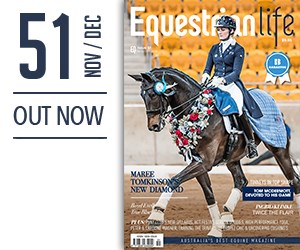
This article has appeared previously with Equestrian Life. To see what's in our latest issue, please click here.
Ingrid Klimke demonstrates training the young horse.
Photo by Susan J. Stickle
By Uwe Spenlen
Why do young horses need to be ridden with the neck stretched forwards and downwards?
The primary goal at the beginning of the training session is to achieve a relaxed back. The movement of a relaxed back should be clearly visible in the rhythm of the gait. A young horse ridden in properly extended posture is therefore able, simply via the traction of its ‘upper tension’ to carry the weight of its own plus the additional weight of the rider, without having to misuse its long back muscle primarily to carry the rider’s weight. In this carriage a young horse also learns very quickly to deal with the rider’s weight to allow its hindquarters mechanism to flow dynamically through the back. As already mentioned, via the poll, this thrust then ultimately ends up in the rider’s hand.
This is the only way in which it is possible for the indispensable contact to be developed from back to front. Rhythm, Relaxation and Contact plus the level of Submissiveness appropriate to the horse’s stage of training are the fundamentals upon which all further education is based. One cannot compromise on these critical points. It is the incorrect seat and mostly too much influence through the rider’s hands which first and foremost hinders the function of the muscles of the back.
The seat of a rider pounding down on the long back muscle in trot makes the horse brace its back and this back muscle tense and cramped. When the horse tries to lighten the rider’s weight on its back by contracting its long back muscle, the back becomes stiff, does not swing anymore and does not let the rider sit. When the rider sits, especially on a young horse, the horse balances him out with the weight of his neck and head. But since the young horse that is still insufficient muscled, the muscles of the horse’s upper neck are still too weak to do the carrying work, the following old rule applies: The heavier the rider, the lower the horse’s head must be initially. We can therefore conclude that the long back muscle is clearly a muscle of movement, the exclusive function of which is the forward movement. The long back muscle is not designed to take vertical pressure and not to carry the rider. It tires soon and starts to hurt.
MUSCLES OF THE HORSE
The goal of our riding is to make the horse’s back ‘swing’. Only a swinging back ensures that the horse is able to carry the rider in the long run without wearing out. And only with a relaxed, swinging back the horse is able to optimally utilise the full potential of his locomotion system and his talent.
Muscles of the horse.
It must be stressed and mentioned again that the horse’s long back muscle only serves locomotion but not to carry the rider’s weight. For a young, untrained horse under saddle it is then a logical consequence to use this nuchal ligament in order to maintain the crucial central requirements for a swinging back. An observant trainer or riding instructor must be able to recognise whether his young horses are on the right track by the development of their muscles as described above.
A horse with a tense or sagged back is impeded in his ability to move. It ‘falls apart’, is disconnected, and it moves insecurely or with tension. His hind legs ‘are out’ and not able to move freely and unconstrained towards the centre of gravity. If we do not allow the long back muscles to swing and allow the movement to get through to the poll to the horse’s mouth, then we destroy the diagonal movement.
CORRECT TROT
If we block the loin area, then the front legs come out and the hind legs do not follow. Then my question is – is this trot? Is this quality we are looking for?
READ THE LATEST NEWS ARTICLES HERE
https://www.equestrianlife.com.au/articles/Forwards-and-down



